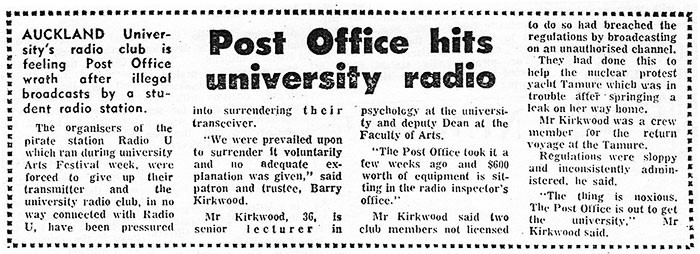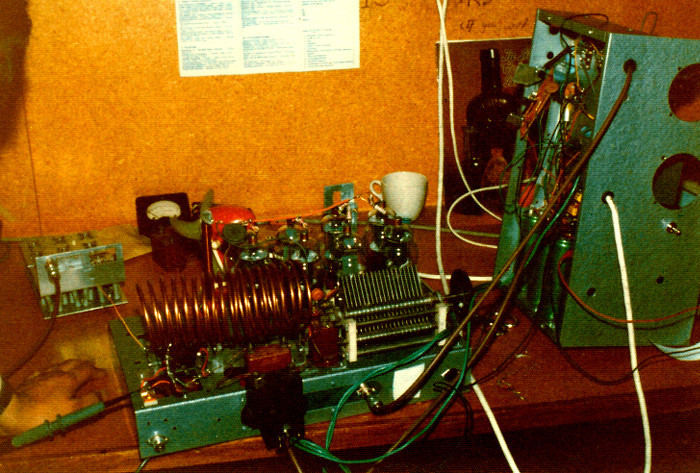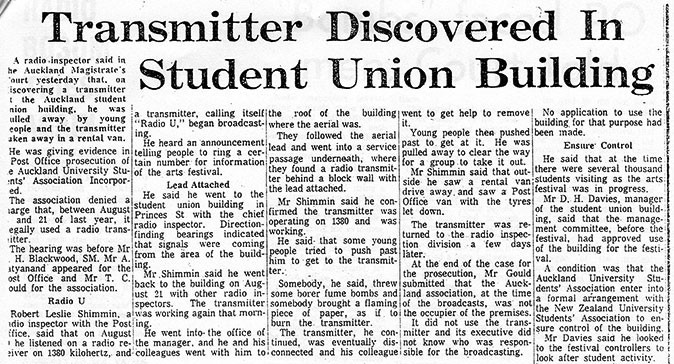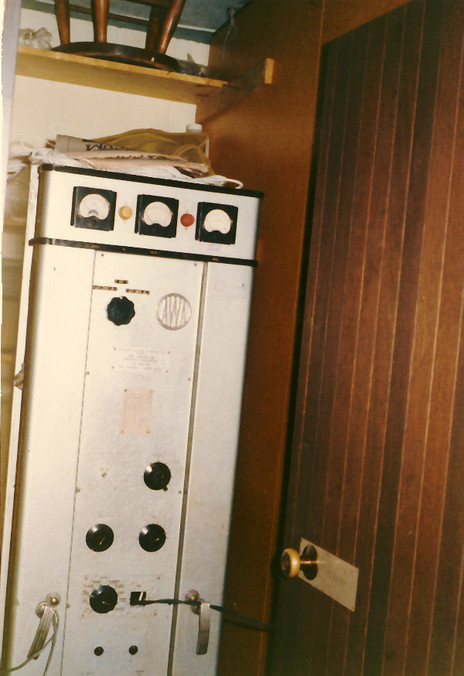The story of Radio B’s pirate broadcasts in the 1970s has been all but lost until now – in part because the pirate adventures were officially nothing to do with B at the time – but they played a remarkable role in the culture of New Zealand radio, and in the changing culture of the country itself. They also had a lot to do with Radio B itself finally getting to air.
After its debut, broadcasting from a boat as a capping stunt in 1969, Radio Bosom settled down and contented itself with delivering “radio” via a network of speakers installed in the quad and around the campus. AUSA submitted several applications to broadcast a low-powered signal to the nearby halls of residence, but regulators didn’t budge.
And so, one day in May 1972 during capping, a new signal lit up. An announcer calling himself Jonathan Schwartz declared that Radio U was broadcasting on 1380AM “from Bean Rock lighthouse in the Hauraki Gulf, in accordance with most regulations of the NZBC.”

Cartoon by Darryl Kirby, May 1972
But, says the New Zealand Herald report of the day, “four Post Office radio inspectors were not fooled for a second. Their radio direction finder was getting suspicious signals from the Student Union building.”
Discovering a door with an on-air light above it, the inspectors entered to find a room full of turntables, microphones and records. The student there explained that he was merely running the university’s internal broadcast system (aka Radio Bosom), which was in no way associated with the pirate broadcasters. The inspectors rightly had their suspicions, but were obliged to leave after they were unable to detect a radio signal.
AUSA’s capping controller also professed no knowledge of a pirate radio station, but the NZ Herald reporter was later led to “a locked door somewhere on campus.”
“The door opened,” reads the Herald’s report. “People filed out, people filed in. In the background, a track from Easy Rider belted out a hard rock sound. It subsided and a student with headphones began his patter. ‘Here we are on 1380 kilohertz for 72 hours only, so make the most of it’.”
All the while, the crack Post Office team was searching the Student Union building. When they go too close, the transmitter would go silent and the “small black box” they were carrying lost the signal. The inspectors came three times in 12 hours, but could not find the transmitter.

Post Office hits university radio - Sunday Times 1 October 1972
The inspectors declared that any subsequent visit would be from the police, alarming the station’s “board of directors”. Jonathan Schwartz, who was said to fancy a legitimate broadcasting career, went on air to declare that, after receiving a call from Wellington from someone who addressed him by his real name, he was pulling out.
But the decision was swiftly reversed and Radio U went back to air. Not long after, the studio telephone, which had received hundreds of calls from well-wishers, rang again. It was the Minister of Broadcasting, Bert Walker.
Mr Walker congratulated the students on the quality of their programme – but warned that they were risking their chances of obtaining a temporary licence in future.
And so it was, after 45 hours on air, that DJ Sunshine Superman thanked Aucklanders for their support and Radio U signed off. The last song played was ‘God Defend New Zealand’.

A radio transmitter in the process of being assembled for Radio Bosom by the radio club in 1973. The chassis is thought to be from the transmitter used for the original Radio Bosom sea-going broadcast and may have been used for early Radio Active broadcasts in Wellington.
Encouraged by the friendly call from the minister, students set about applying to the Broadcasting Authority for a 10-day broadcast warrant to publicise a festival organised by the universities’ arts council for August. The New Zealand DX Times, the journal of the country’s radio hobbyists since 1948, was supportive and believed the students had an excellent chance of approval.
But there was notably little support for Radio U from the former pirates at Radio Hauraki. As part of the Federation of Independent Commercial Broadcasters – Radio i was the other member – Hauraki opposed Radio U’s application, warning that were it approved, “the Broadcasting Authority could get a flood of applicants for temporary warrants.”

'Bombs faced PO Men, Court Told' (21 July 1973)
The students’ application was declined. It was not the last time commercial broadcasters, founded in the name of radio freedom, would line up against the B.
But as they prepared to seize the equipment, three borer bombs were thrown into the tunnel, filling it with smoke.
On 20 August, Radio U began broadcasting illegally again. The Post Office inspectors returned – and this time they were more successful. After following a wire down from the roof of the student union building the inspectors located a transmitter behind a brick wall in a tunnel underneath it. But as they prepared to seize the equipment, three borer bombs were thrown into the tunnel, filling it with smoke.
“While a mass of students held the inspectors at arms reach, other students came from the other end of the tunnel,” the Auckland Star reported. “They grabbed the transmitter, loaded it into a truck, then whipped it off.”
“The inspectors took it all rather well, considering,” a student spokesman told the Star.
Actually, not that well. The Post Office divisional engineer in Auckland, Mr A.D. Gifkins, was determined that charges be laid over what he called “a serious transgression of the law.”
Meanwhile, minister Walker was questioned in Parliament by Labour MP Bob Tizard. Had he in fact given the students an undertaking in May that they would get a temporary licence? No, the minister insisted, he had merely advised them of the penalties they faced for broadcasting illegally and told them to apply in the proper manner.
In July 1973, the case came to court and the AUSA was in the dock, charged with illegal use of a radio transmitter. Post Office radio inspector Robert Shimmin told the court that he and his colleagues had located an aerial on the roof of the student union building, but the Star reported, “he and the other inspectors had difficulty getting off the roof because someone had locked the door to the roof behind them.”

'Transmitter discovered in Student Union Building'
Worse, when they went to pursue the students with the transmitter, they discovered that the tyres of their Post office van had been let down.
Eventually, the argument of AUSA’s lawyer – that the student union building was substantially under the control of NZUSA, not AUSA, at the time of the pirate broadcasts – prevailed and the prosecution failed.
In all this time, the identities of the student pirates were never revealed. What was their story? How had they pulled it off?
“Jonathan Schwartz” was actually Glenn Smith, the manager of the officially unconnected Radio Bosom. A radio obsessive since childhood (while at school, he won a competition that gave him an afternoon show on 1ZB, where he chose his own music, an unprecedented half of which came from New Zealand artists), Smith did indeed go on to a professional radio career – all of which has been at the steadfastly independent 1XX in Whakatane.
Smith recalls that Walker was quite cordial when he called the station, but admits to being “kind of freaked out” by the mysterious caller from Wellington who knew his name. “It was almost like they had the SIS on us.”
There was another tricky conversation: with his mum.
“I did an interview with Town and Around and I was blanked out. We did it at Chris Cotton’s house in Herne Bay, where we were recording. And then I was sitting watching TV with my mother and she said ‘Is that you?’ and I had to say, ‘Yeah, it is actually’. She was okay.”
Another of those involved was Robert Gordon, who recalls that the pirates installed a switch in the Radio Bosom studio, allowing them to turn off the source of the source of the broadcasts – a tape player down in the basement locker room, which was in turn connected to the transmitter. They also did their best to disguise the connecting wires and the aerial on the roof.
The final Radio U broadcasts were, Gordon confirms, a matter of frustration: “When we didn't get the licence, we’d got our transmitter already and we thought bugger it, we’ll go on air anyway.”
Gordon says the inspectors initially tried to park their van in the basement carpark next to the student union building – but were refused entry because they lacked the correct sticker. They then summoned some plainclothes policemen – who promptly got lost. The inspectors sought out a map of the building.
“But the Student Union custodian made himself scarce. They eventually found someone in the chemistry building who gave them plans and that’s how they found the tunnel.”
The service tunnel was accessible from the former café on the ground floor of the building and from the carpark. Again, considerable effort – including the bricking up of the tunnel – went into concealing of the transmitter.

The Collier & Beale radio transmitter that was removed by Post Office radio inspectors from the services tunnel during a pirate AM broadcast. The Post Office eventually returned the transmitter and it was used it for all subsequent Radio B AM broadcasts. Technicians had to tap the valves with a ballpoint pen for them to work properly when the transmitter was switched on. If an arc formed, the technician received a shock.
It was a stroke of luck that the night before there had been a gig in the café. The pirates, realising that that the inspectors had found the transmitter and were breaking down the brickwork, asked the driver of a hired van loading out gear from the café to help.
The intervention of the crowd of students – like the letting down of the tyres – was wholly spontaneous. And as the inspectors were preparing to seize it, “they took the transmitter off them and threw it into our van, which went screaming off into the distance.”
News reports at the time said the transmitter – a big piece of marine kit, all of six feet high – was “returned” to the Post Office several days later. The reality was a little more complex, says Gordon. It was successfully hidden at the Herne Bay home of Chris Cotton, which had been the location for pre-recording of programmes.

'Hauraki and Radio i oppose Radio U'
“Ultimately, the police started putting a bit of pressure on the guy who had rented the van – they’d stop him in the street and search him for marijuana – so he came to us and asked whether we could do anything about it. So we agreed to hand over the transmitter.
“We left it under the harbour bridge for them – with a can of beer and six straws, for some reason. And a little ribbon around it.”
Less than a year after the court case, everything changed. The Kirk Labour government had scrapped the existing Broadcasting Act and abolished the Authority and in February 1974, Radio Bosom was granted a licence to broadcast for three weeks in March. It was the first licence to non-commercial pirate radio, the first to a university and the first short-term licence.
Walker, by then in Opposition, subsequently lamented that the licence had gone to the students and not to the would-be Christian broadcaster Radio Rhema. But it may be that it was his friendly phone call to the pirates that set it all in motion.
It was not, however, the end of the pirate adventure. While happy to finally be legally on air on the AM band, the students turned their attention to FM – which the government was steadfastly refusing to introduce.
“We were more concerned about FM,” says Gordon, “because there was no FM in the country back then and the sort of music we were playing was alternative music, which was more suited to FM.”
FM broadcasts were made as Capping Radio from the Radio B studio via an aerial on top of the Chemistry building. More regular broadcasts as Radio Auckland were pre-recorded and delivered on Friday nights from the top of the former ASB building in Queen Street. The pirates had a campaigning agenda and in 1977 they even set up an FM transmitter and broadcast in Wellington to bring the protest closer to the politicians.
While Radio Hauraki’s management was doing its best to prevent Radio B getting on air, some of its announcers took quite a different view.
“We had Kevin Black and Fred Botica from Radio Hauraki doing spots,” says Gordon. “And Merv Smith was going to do it as well, but he decided it was too risky for his career. So there was a lot of push from the actual broadcasters to try and more of a range of music on the air. They themselves were very concerned about the limited options that were available on radio.”
The $250 transmitter was surrendered but the pirates were never caught. They retired undefeated.
The broadcasts ended as the pirates moved on into the world, but there was a pirate “reunion” in 1980. By this time, the pirates were slick. On the Thursday before Easter, they donned overalls and posed as maintenance workers to plant an aerial and transmitter on the roof of the university’s chemistry building. A second transmitter was placed in a van to deliver to the North Shore. Friends acted as operators on six phone lines and took more than $1,000 in pledges for several charities.
And, finally, a mixing desk was set up in the bedroom of a flat in Newton, disguised so it could be passed off as a sophisticated home stereo. Jocks from both the NZBC and the private stations came to take turns on the midday-to-midnight FM broadcasts.
“We all thought it was ludicrous that New Zealand was still one of the few countries in the world without FM,” one of the pirates later told the Woman’s Weekly. “We were prepared to break the law to prove a point.”
It took until Easter Monday for police and Post Office inspectors to find the transmitter – and as they did, the pirates, who had been watching them all along, shut down their studio by remote control. The $250 transmitter was surrendered but the pirates were never caught. They retired undefeated.
So did the pirate FM campaign eventually force the government to move? “Yes,” says Gordon. “I think both the AM and FM broadcasts did have an impact. It became political.”
But this was not the end of Radio B’s role in the FM radio story. In the 1980s, the station would again take a role that upset the establishment.
--
Read BFM - the first ten years - here
A history of New Zealand student radio, by RNZ's The Wireless